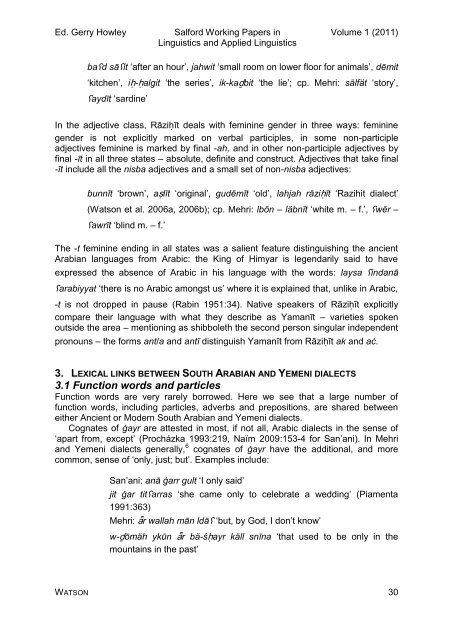South Arabian and Yemeni Dialects
South Arabian and Yemeni Dialects
South Arabian and Yemeni Dialects
Create successful ePaper yourself
Turn your PDF publications into a flip-book with our unique Google optimized e-Paper software.
Ed. Gerry Howley Salford Working Papers in<br />
Linguistics <strong>and</strong> Applied Linguistics<br />
Volume 1 (2011)<br />
baʕd sāʕit ‘after an hour’, jahwit ‘small room on lower floor for animals’, dēmit<br />
‘kitchen’, iḥ-ḥalgit ‘the series’, ik-kaḏbit ‘the lie’; cp. Mehri: sälfät ‘story’,<br />
ʕaydīt ‘sardine’<br />
In the adjective class, Rāziḥīt deals with feminine gender in three ways: feminine<br />
gender is not explicitly marked on verbal participles, in some non-participle<br />
adjectives feminine is marked by final -ah, <strong>and</strong> in other non-participle adjectives by<br />
final -īt in all three states – absolute, definite <strong>and</strong> construct. Adjectives that take final<br />
-īt include all the nisba adjectives <strong>and</strong> a small set of non-nisba adjectives:<br />
bunnīt ‘brown’, aṣlīt ‘original’, gudēmīt ‘old’, lahjah rāziḥīt ‘Razihit dialect’<br />
(Watson et al. 2006a, 2006b); cp. Mehri: lbōn – läbnīt ‘white m. – f.’, ʕwēr –<br />
ʕawrīt ‘blind m. – f.’<br />
The -t feminine ending in all states was a salient feature distinguishing the ancient<br />
<strong>Arabian</strong> languages from Arabic: the King of Himyar is legendarily said to have<br />
expressed the absence of Arabic in his language with the words: laysa ʕindanā<br />
ʕarabiyyat ‘there is no Arabic amongst us’ where it is explained that, unlike in Arabic,<br />
-t is not dropped in pause (Rabin 1951:34). Native speakers of Rāziḥīt explicitly<br />
compare their language with what they describe as Yamanīt – varieties spoken<br />
outside the area – mentioning as shibboleth the second person singular independent<br />
pronouns – the forms ant/a <strong>and</strong> antī distinguish Yamanīt from Rāziḥīt ak <strong>and</strong> ać.<br />
3. LEXICAL LINKS BETWEEN SOUTH ARABIAN AND YEMENI DIALECTS<br />
3.1 Function words <strong>and</strong> particles<br />
Function words are very rarely borrowed. Here we see that a large number of<br />
function words, including particles, adverbs <strong>and</strong> prepositions, are shared between<br />
either Ancient or Modern <strong>South</strong> <strong>Arabian</strong> <strong>and</strong> <strong>Yemeni</strong> dialects.<br />
Cognates of ġayr are attested in most, if not all, Arabic dialects in the sense of<br />
‘apart from, except’ (Procházka 1993:219, Naïm 2009:153-4 for San’ani). In Mehri<br />
<strong>and</strong> <strong>Yemeni</strong> dialects generally, 6 cognates of ġayr have the additional, <strong>and</strong> more<br />
common, sense of ‘only, just; but’. Examples include:<br />
San’ani: anā ġarr gult ‘I only said’<br />
jit ġar titʕarras ‘she came only to celebrate a wedding’ (Piamenta<br />
1991:363)<br />
Mehri: ǟr wallah mān ldāʕ ‘but, by God, I don’t know’<br />
w-ḏōmäh ykūn ǟr bä-śḥayr käll snīna ‘that used to be only in the<br />
mountains in the past’<br />
WATSON 30
















